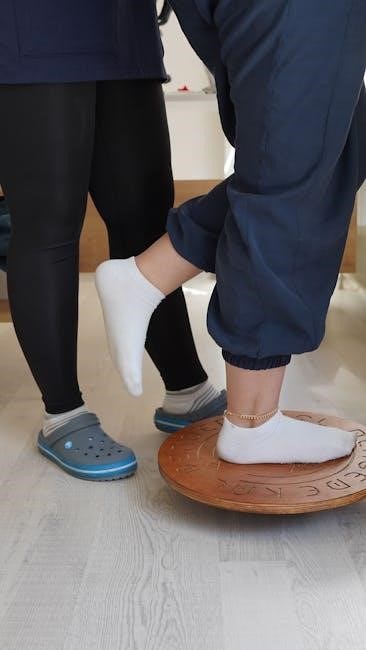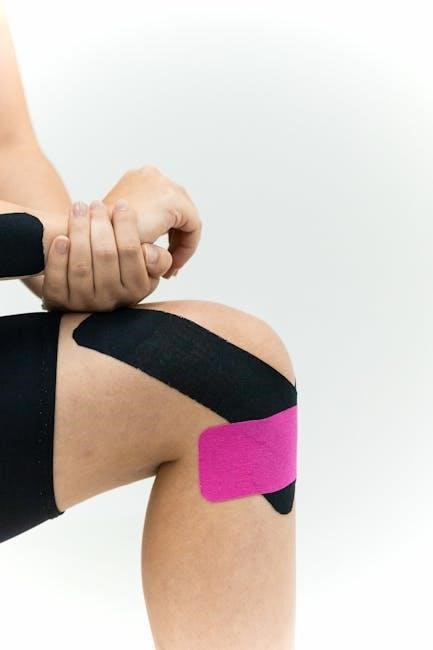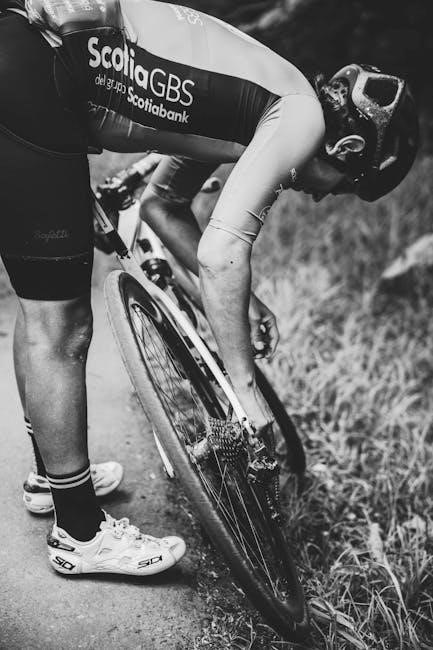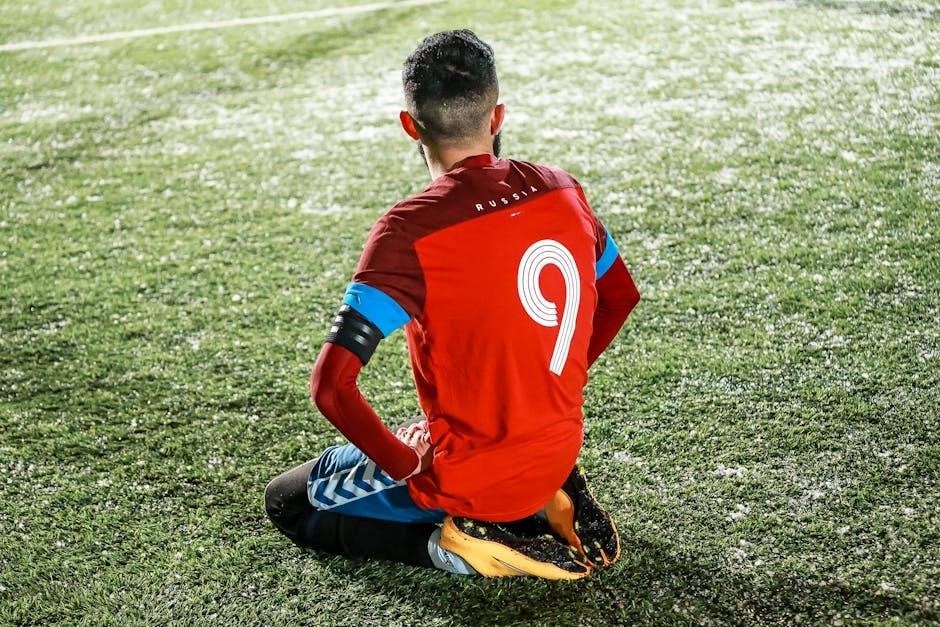Knee bursitis exercises are essential for reducing inflammation and restoring mobility. Gentle stretches and strengthening movements, like straight leg raises and heel slides, promote healing and flexibility.
Overview of Knee Bursitis
Knee bursitis is a condition characterized by inflammation of the bursae, small fluid-filled sacs that cushion the knee joint and reduce friction between bones, tendons, and soft tissues. It often results from repetitive motion, direct blows, or prolonged kneeling. Common types include prepatellar bursitis (in front of the kneecap) and infrapatellar bursitis (below the kneecap). Symptoms may include swelling, pain, and limited mobility. While it can affect anyone, it is most common among athletes, individuals with repetitive knee movements, or those who frequently kneel. Early intervention, such as gentle exercises and rest, can help manage symptoms and prevent complications. PDF guides and physical therapy resources provide structured exercise routines to address knee bursitis effectively, focusing on strengthening and flexibility to support recovery and prevent recurrence.
Understanding the Symptoms
The symptoms of knee bursitis typically include pain, swelling, and limited mobility around the knee joint. Pain may be sharp or dull, often worsening with activities like kneeling, bending, or prolonged sitting. Swelling and redness around the affected bursa are common, and the area may feel warm to the touch. In some cases, movement becomes restricted, making everyday tasks challenging. It’s important to recognize these signs early to begin appropriate treatment, including targeted exercises and rest. PDF guides and professional resources provide detailed insights into managing these symptoms through exercise routines, emphasizing the importance of addressing them promptly to avoid further complications and promote a full recovery.
The Importance of Exercises for Knee Bursitis

Exercises strengthen muscles, improve flexibility, and reduce inflammation. Consistency is key for recovery and preventing future episodes of knee bursitis.
Benefits of Exercise for Knee Health
Exercise plays a crucial role in improving knee health by strengthening the surrounding muscles, enhancing flexibility, and reducing inflammation. Regular movement helps maintain joint mobility and prevents stiffness. Strengthening the quadriceps and hamstrings provides stability, reducing stress on the knee joint. Additionally, exercise promotes blood flow, which aids in healing and reduces swelling associated with bursitis. Gentle stretching improves range of motion, making daily activities easier. Consistent exercise routines also help prevent future episodes of knee pain and inflammation. By incorporating both strengthening and flexibility exercises, individuals can achieve long-term knee health and reduce the risk of complications. A well-structured exercise plan is essential for managing knee bursitis effectively.
Creating a Safe Exercise Routine
Creating a safe exercise routine for knee bursitis involves gradual progression and careful planning. Start with low-intensity exercises like straight leg raises and heel slides, ensuring comfort and avoiding pain. Warm up before each session to prepare muscles and joints. Use supportive gear such as knee braces if needed. Avoid high-impact activities that strain the knee. Each exercise should be performed with proper form to prevent further injury. Rest periods between sets allow muscles to recover. Consulting a physical therapist can help tailor the routine to individual needs, ensuring effectiveness and safety. Progress slowly, increasing intensity only when discomfort subsides. Consistency is key, but so is listening to your body to avoid overexertion. A balanced approach ensures long-term benefits without risking aggravation of the condition.

Recommended Exercises for Knee Bursitis
Knee bursitis exercises focus on strengthening muscles around the knee, improving flexibility, and reducing inflammation. Gentle movements like straight leg raises and heel slides are often recommended.
Straight Leg Raises
Straight leg raises are a fundamental exercise for addressing knee bursitis. Begin by lying on your back with the unaffected leg bent and the affected leg straight. Tighten the thigh muscles of the affected leg by pressing the back of your knee down toward the floor. Slowly lift your straight leg to a height of about 12 inches, keeping it straight throughout the movement. Hold for 6 seconds, then lower your leg slowly. Repeat this exercise 8 to 12 times per session.
This exercise strengthens the quadriceps muscles without placing additional stress on the knee joint, making it ideal for early-stage recovery. It also helps improve knee mobility and reduces stiffness; Start with fewer repetitions and gradually increase as your strength improves.
Heel Slides
Heel slides are a gentle and effective exercise for knee bursitis. Start by lying on your back with your legs straight. Slowly slide the heel of your affected leg toward your buttocks, bending your knee as you go. Keep your foot flexed and your thigh muscles relaxed. Hold for a few seconds, then slowly return to the starting position. Repeat this exercise 8 to 12 times per session.
This movement helps improve knee flexibility and reduces stiffness. Avoid using your hands to assist the movement, as this can reduce the effectiveness of the exercise. Perform heel slides 2 to 3 times daily to enhance mobility and strength in the knee joint.
Quad Sets
Quad sets are a foundational exercise for strengthening the quadriceps muscles, which support the knee joint. To perform this exercise, sit or lie down with your legs straight. Tighten the muscles in the front of your thigh by pressing the back of your knee into the floor or bed. Hold this position for 5 to 10 seconds, then release. Repeat this 10 to 15 times per session.
Quad sets improve muscle tone and stability around the knee, reducing the risk of further inflammation. Focus on maintaining a straight leg and avoid using hand assistance. Perform this exercise 2 to 3 times daily to enhance knee strength and stability, aiding in the recovery from knee bursitis.
Step-Ups
Step-Ups are an effective exercise for strengthening the muscles around the knee, particularly the quadriceps and hamstrings. To perform this exercise, stand in front of a sturdy step or platform (about 4-6 inches high). Step up onto the platform with your affected leg, bringing your other leg up to meet it. Then, slowly step back down to the starting position, beginning with the same leg.
Focus on maintaining proper form to avoid putting unnecessary strain on your knee. Start with a low step and gradually increase the height as your strength improves. Aim for 2-3 sets of 8-12 repetitions daily. Step-Ups improve knee stability, strength, and mobility, making them an excellent addition to your knee bursitis exercise routine.
Wall-Assisted Knee Bends
Wall-Assisted Knee Bends are a gentle and effective exercise for improving knee mobility while minimizing strain. Stand with your back against a wall and feet about 12 inches away from the wall. Slowly slide down the wall by bending your knees, keeping your back pressed against it. Bend your knees to a comfortable angle (about 30-45 degrees) and hold for 10-15 seconds. Straighten your legs to return to the starting position.
This exercise strengthens the quadriceps and improves knee flexibility. Perform 2-3 sets of 8-12 repetitions daily. It is particularly useful for individuals with limited mobility or those in the early stages of recovery. Avoid bending too deeply if pain occurs. This low-impact exercise helps restore knee function gradually and safely.
Hamstring Stretches
Hamstring stretches are a critical component of knee bursitis exercises, as tight hamstrings can exacerbate knee strain. To perform this exercise, sit on the floor with your legs extended straight in front of you. Loop a towel around the ball of one foot and gently pull it toward your chest until you feel a stretch in the back of your thigh. Hold this position for 20-30 seconds, then release. Repeat on the other side.
For a standing variation, lean forward from the hips while keeping your knees slightly bent. This stretch can be modified to suit discomfort levels. Perform 2-3 sets daily to improve flexibility and reduce tension in the hamstrings, which indirectly supports knee health and mobility. Consistency is key to achieving lasting benefits.
Calf Stretching Exercises
Calf stretching exercises are beneficial for knee bursitis as they improve flexibility and reduce tension in the lower leg muscles, which can influence knee function. To perform a standing calf stretch, stand facing a wall with one hand on it for balance. Step one foot back about a foot, keeping your heel on the ground and your knee straight. Bend the front knee slightly and lean forward until you feel a stretch in your calf. Hold for 20-30 seconds, then switch sides.
For a seated version, extend your legs straight in front of you and loop a towel around the ball of one foot. Gently pull your toes toward your head until you feel a stretch in your calf. Hold for 20-30 seconds and repeat twice on each side. Regular calf stretching can enhance overall lower limb mobility and support knee recovery. Consistency is essential for optimal results.
Side-Lying Leg Lifts
Side-lying leg lifts are an excellent exercise for strengthening the hip abductors and improving knee stability. Lie on your side with your legs straight and feet touching. Slowly lift the top leg away from the bottom leg, keeping your knee straight, and hold for 2-3 seconds. Lower your leg slowly to the starting position. Perform 2-3 sets of 10-15 repetitions on each side. This exercise helps strengthen the muscles around the hip and knee, reducing strain on the bursae. It also enhances balance and coordination, which are crucial for overall knee health. Consistency in performing this exercise can lead to improved mobility and reduced discomfort associated with knee bursitis.

Advanced Exercises for Progression
Advanced exercises, like balance training and resistance band workouts, help strengthen muscles around the knee, improving stability and reducing bursitis discomfort over time.
Balance Training Exercises
Balancing exercises are crucial for improving stability and strength around the knee joint, which is essential for managing knee bursitis. These exercises help enhance proprioception, or the body’s ability to sense its position, which is often diminished when the knee is injured or inflamed. Simple activities like standing on one leg or using a wobble board can be effective. Start by standing on the affected leg while holding onto a chair for support. Gradually increase the duration and remove the support as balance improves. Incorporating balance training into your routine can significantly reduce the risk of further knee issues and promote overall lower limb stability.
Resistance Band Training
Resistance band training is an excellent way to strengthen the muscles around the knee, improving stability and reducing bursitis symptoms. Using a resistance band, you can perform exercises like seated leg presses or lateral walks. These movements target the quadriceps, hamstrings, and glutes, which are essential for knee support. Start with light resistance and gradually increase as your strength improves. Ensure proper form to avoid strain. Resistance bands are portable and versatile, making them ideal for home workouts. They also provide low-impact stress on the knee joint, which is beneficial for those with bursitis. Regular use of resistance bands can enhance muscle endurance, improve joint stability, and reduce pain. Always consult a physical therapist to tailor the exercises to your specific condition and avoid further injury.

Prevention of Knee Bursitis
Preventing knee bursitis involves avoiding direct blows, using protective gear, and maintaining a daily stretching routine to keep muscles flexible and strong around the knee joint.
Avoiding Direct Blows to the Knee
Preventing direct blows to the knee is crucial for avoiding bursitis. Activities that involve repetitive kneeling or direct impact should be minimized. Using protective gear like knee pads can significantly reduce the risk of injury. If your job or hobby involves kneeling, consider using gel or foam padding to cushion the knee area. Additionally, wearing proper sports equipment during physical activities can help protect the knee from sudden impacts. By being mindful of your knee positioning and avoiding repetitive stress, you can lower the chances of developing knee bursitis. This proactive approach ensures long-term knee health and prevents unnecessary discomfort.
Using Protective Gear
Using protective gear is a key strategy in preventing knee bursitis. Knee pads and braces provide cushioning and support, reducing friction and impact on the knee joint. For individuals who frequently kneel, such as construction workers or gardeners, gel or foam knee pads can offer exceptional comfort. Athletic activities benefit from neoprene sleeves, which provide warmth and stability. Ensuring proper fit is essential to avoid additional pressure points. Protective gear not only prevents direct blows but also reduces the risk of repetitive strain injuries. By incorporating protective measures, individuals can maintain knee health and engage in daily activities without discomfort. This simple yet effective approach is vital for long-term knee protection and overall well-being.
Daily Stretching Routine
A daily stretching routine is crucial for maintaining knee flexibility and preventing bursitis flare-ups. Incorporate gentle exercises like hamstring and calf stretches to support knee health. Start with 10-15 minute sessions, focusing on controlled movements. Stretching the hamstrings involves sitting on the floor with legs extended and reaching toward your toes, holding for 20-30 seconds. Calf stretches can be done by leaning against a wall with one leg back, pressing your heel toward the ground. Consistency is key, as regular stretching improves joint mobility and reduces stiffness. Even if symptoms subside, maintaining a daily routine helps prevent future issues. Always prioritize gentle movements to avoid overexertion. Consult a healthcare professional to tailor your routine to your specific needs and ensure optimal results.

Recovery and Stretching Techniques
Recovery involves rest, ice therapy, and gentle stretching to reduce inflammation. Techniques like heel slides and quad sets help restore mobility and strength, supporting the healing process.
Rest and Ice Therapy
Rest and ice therapy are crucial for managing knee bursitis. Applying ice packs to the affected area reduces swelling and eases pain. It is recommended to apply ice for 15-20 minutes several times a day. Resting the knee avoids further strain and allows the bursa to heal. Elevating the leg can also help reduce inflammation. Combining these methods with gentle exercises, such as straight leg raises, can promote recovery while maintaining strength and flexibility. Consistency is key to prevent recurrence and ensure proper healing of the knee joint.
Stretching Exercises for Flexibility
Stretching exercises are vital for improving flexibility and reducing stiffness in knee bursitis. Hamstring and calf stretches are particularly beneficial, as they target muscles around the knee joint. To perform a hamstring stretch, sit on the floor with your legs extended and lean forward gently until you feel a stretch in the back of your thigh. For calf stretches, stand facing a wall with one hand on the wall for balance and extend one leg behind you, keeping your heel on the ground. Hold each stretch for 20-30 seconds and repeat 2-3 times. Incorporating these stretches into your daily routine, especially after physical activity, can significantly enhance mobility and reduce discomfort associated with knee bursitis.
Consistency in Exercise Routine
Maintaining consistency in your exercise routine is crucial for managing knee bursitis effectively. Regular practice helps strengthen the muscles around the knee, improving stability and reducing inflammation. Even mild exercises, when performed daily, can lead to significant improvements over time. It’s important to set aside time each day to perform stretches and strengthening exercises, as irregular practice may hinder progress. Gradually increasing the intensity and duration of workouts ensures sustained benefits without overexertion. Consistency also plays a key role in preventing future flare-ups by enhancing joint flexibility and muscle endurance. Sticking to a structured routine, as outlined in knee bursitis exercise guides, fosters long-term recovery and overall knee health.

Resources for Knee Bursitis Exercises
Downloadable PDF guides provide detailed knee bursitis exercise programs, including illustrations and step-by-step instructions for stretches and strengthening routines to aid in recovery and prevention.
Downloadable PDF Guides
Downloadable PDF guides offer comprehensive exercise plans for knee bursitis, featuring detailed instructions, images, and routines. These resources are ideal for home use, providing structured programs to improve flexibility and strength. Many guides include stretches like heel slides and quad sets, along with strengthening exercises such as straight leg raises. They often cater to different recovery stages, ensuring gradual progression. Physical therapists and healthcare providers frequently recommend these guides for their clarity and effectiveness. Users can print or access them digitally, making it easy to follow along during daily routines. These PDFs are valuable tools for managing knee bursitis and preventing future flare-ups, emphasizing consistency and proper technique.
Role of Physical Therapists
Physical therapists play a crucial role in guiding knee bursitis exercises, ensuring safety and effectiveness. They assess individual needs, develop personalized exercise plans, and demonstrate proper techniques. Therapists focus on strengthening muscles around the knee, improving flexibility, and enhancing joint stability. They often incorporate exercises like straight leg raises and heel slides, tailored to the patient’s condition. Their expertise helps prevent overexertion and promotes gradual progress. Many therapists provide downloadable PDF guides for home use, making it easier for patients to follow routines consistently. Regular sessions with a physical therapist can significantly accelerate recovery and reduce the risk of future bursitis flare-ups. Their support and guidance are invaluable for achieving long-term knee health and mobility.



